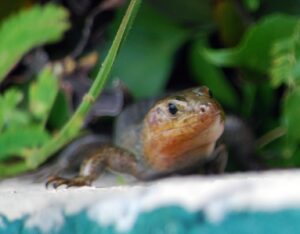The Bermuda skink (Plestiodon longirostris), also known as the Bermuda rock lizard or Bermuda rock skink, is a critically endangered lizard species found only on the island of Bermuda. As the only native terrestrial reptile in Bermuda, the skink holds a unique ecological role in the island’s ecosystem. Despite its small size and elusive nature, this fascinating creature has become a symbol of the island’s rich biodiversity and the urgent need for conservation efforts.

Physical Characteristics
The Bermuda skink is a small lizard, reaching a maximum length of about 4 inches (10 cm). Its slender body is adorned with a brownish-gray colouration and a distinct pattern of light and dark bands that run the length of its body. The skink’s elongated snout is perfectly adapted for reaching into crevices and beneath rocks in search of food.
Habitat and Diet of the Bermuda Skink
Found primarily in rocky shorelines, limestone cliffs, and coastal scrublands, Bermuda skinks are adept at navigating their unique habitat. These elusive lizards are primarily insectivorous, preying on small insects, spiders, and other invertebrates. However, they have also been known to consume plant materials, such as fruits and seeds, on occasion.
Threats and Conservation
Unfortunately, the Bermuda skink population has experienced a significant decline due to several factors, including habitat loss, predation by invasive species, and human activities. Coastal development has led to the destruction of much of the skink’s natural habitat, while invasive species, such as rats and feral cats, pose a serious threat through predation.
Recognising the urgent need for action, the Bermuda Government launched a five-year recovery plan in 2016 to help conserve this unique species. The plan focuses on habitat restoration, population monitoring, and captive breeding programs. Efforts have been made to restore and protect the skink’s habitat by removing invasive plant species and creating artificial nesting sites to increase breeding success.
Captive breeding programs have also been established in collaboration with international zoos and wildlife organisations. The goal is to increase the genetic diversity of the skink population and release healthy individuals back into the wild. Public education and awareness campaigns have been initiated to promote the importance of protecting the Bermuda skink and its habitat.
Conclusion
The Bermuda skink is a unique and valuable part of the island’s ecosystem, but its existence is threatened by habitat loss, invasive species, and human activities. Through ongoing conservation efforts and increased public awareness, there is hope that this rare treasure of the Atlantic will be saved from the brink of extinction. By protecting the Bermuda skink, we are also preserving the natural heritage of Bermuda for future generations to appreciate and enjoy.


